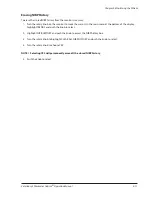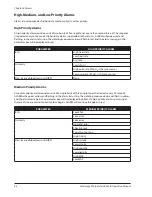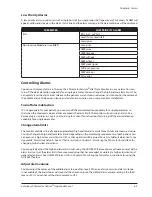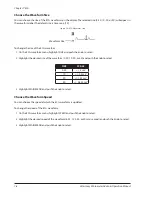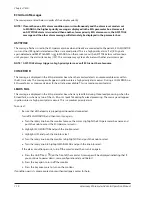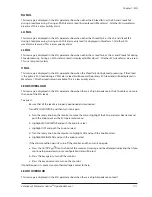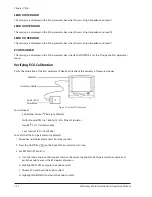
Chapter 6: Alarms
Veterinary 3 Parameter Advisor
®
Operation Manual
6-3
Low Priority Alarms
A low priority alarm sound consists of a single burst of two single tones that repeat every 20 seconds. ALARM will
appear, yellow and steady, in the alarm status line and the alarm message in the parameter box will be displayed.
PARAMETER
LOW PRIORITY ALARM
ECG
RA, LA, LL, or V fail
Lead I fail or Lead II fail
Low signal
Non-invasive blood pressure (NIBP)
Com error
NIBP error
NIBP timeout
NIBP cuff leak
NIBP artifact
NIBP weak signal
Cuff over-pressure
NIBP cal error
Valve error
Controlling Alarms
You can control many factors in the way the 3 Parameter Advisor
®
Vital Signs Monitor issues an alarm. You can
turn off the alarm detection capability for a single parameter. You can change the high and low alarm limits. You
can quickly reset the alarm limits relative to the patient’s current measured values. You can control the volume of
the audible alarm. And you can silence an alarm for two minutes, or on some monitors, indefinitely.
Turn off alarm detection
If it is appropriate for your patient, you can turn off the alarm detection capability for a single parameter so
that when the measured value matches or exceeds the alarm limits, the monitor will not issue an alarm. See
Responding to an Alarm
in
Chapter 5: Monitoring the Patient
for instructions for turning off the alarm detection
capability for a single parameter.
Change alarm limits
The monitor provides clinically appropriate default high and low alarm limits for each numeric measured value.
You can change the high and low alarm limits, depending on the monitoring requirements of each patient. You
can even set a high or low alarm limit to OFF, so that no alarm will be issued. For a list of default alarm limits, see
Appendix B: Alarm Limit Defaults
. See
Set the Alarm Limits
in
Chapter 5: Monitoring the Patient
for instructions for
changing high and low alarm limits.
You can quickly adjust the high and low alarm limits using the QUICKSET feature. You may choose to reset all the
alarm limits, or just the alarm limits for a measured value that has exceeded, or violated, a high or low limit and
generated an alarm. See
QUICKSET Alarm Limits
in
Chapter 5: Monitoring the Patient
for instructions for using the
QUICKSET feature.
Adjust alarm volume
You can adjust the volume of the audible alarm to one of ten levels. When an alarm occurs (and alarm silence
is not enabled), the alarm tones will sound at the chosen volume. The default alarm volume setting is the third
level, or 30%. You cannot set the alarm volume to OFF.
Содержание SurgiVet Advisor WWV9230
Страница 2: ......
Страница 10: ...Table of Contents viii Veterinary 3 Parameter Advisor Operation Manual This page is intentionally left blank ...
Страница 68: ...Chapter 7 ECG 7 14 Veterinary 3 Parameter Advisor Operation Manual This page is intentionally left blank ...
Страница 80: ...Chapter 8 Oximetry 8 12 Veterinary 3 Parameter Advisor Operation Manual This page is intentionally left blank ...
Страница 106: ...Chapter 12 Service Menu 12 8 Veterinary 3 Parameter Advisor Operation Manual This page is intentionally left blank ...
Страница 120: ...Appendix D Revision History D 2 Veterinary 3 Parameter Advisor Operation Manual This page is intentionally left blank ...
Страница 121: ......











